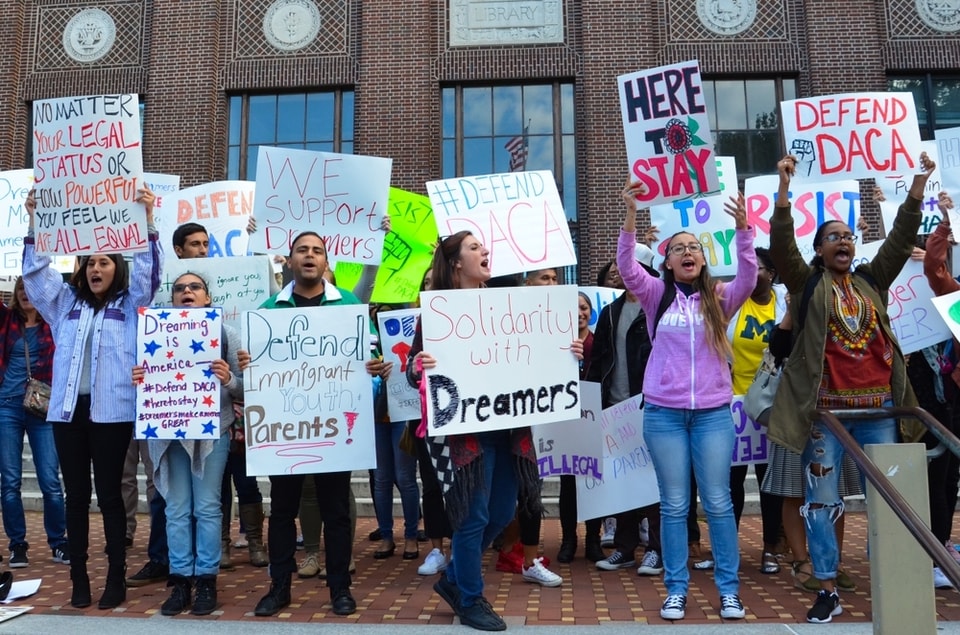Memo Published March 29, 2019 · Updated April 1, 2019 · 7 minute read
What you Need to Know about the Dream and Promise Act
Akua Amaning & Nathan Kasai

Congress is once again considering protections for Dreamers, as well as for recipients of the Temporary Protected Status (TPS) and Deferred Enforcement Departure (DED) programs, which provide narrow relief to immigrants from specific distressed countries. The American Dream and Promise Act of 2019 (H.R. 6) would block the Trump administration’s draconian attempts to abruptly terminate these programs and shield immigrants with strong ties to the United States from deportation to unsafe or unfamiliar places. As Congress debates the bill, here is a quick rundown of the programs it intends to protect, and why it is imperative to pass it as soon as possible.
Who is Protected by the Dream and Promise Act?
The Dream and Promise Act would provide protection from deportation and an earned pathway to citizenship for recipients of the Deferred Action for Childhood Arrivals (DACA), TPS, and DED programs.
- Deferred Action for Childhood Arrivals: DACA was implemented by the Obama administration in 2012 to grant protection against deportation and work authorization to undocumented immigrants brought to the United States as children. Those eligible for the program must have entered the United States before the age of 16 and must have been under 31 on June 15, 2012. DACA recipients must also meet certain educational, criminal, and national security requirements to receive or maintain their legal status. There are around 800,000 individuals currently enrolled in the program. And for now, the administration has continued to renew DACA permits, but it refuses to accept any new applications from eligible immigrants.1
- Temporary Protected Status: The TPS program offers renewable protections from deportation for people living in the United States who are from a list of specified countries where the US government has determined it is not safe for them to return, typically because of war or natural disasters. There are currently over 300,000 people from ten countries who are legally in the country under TPS—from El Salvador, Honduras, Haiti, Nepal, Nicaragua, Somalia, Sudan, South Sudan, Syria, and Yemen.2 And the typical TPS recipient has lived in the US and established deep roots within their local communities for the last 15 to 20 years.3
- Deferred Enforcement Departure: DED functions similarly to TPS and allows foreign nationals from specific countries recovering from conflicts or disasters to remain and work in the United States. However, unlike TPS, the President has sole discretion to authorize DED status and set eligibility requirements, rather than the Secretary of Homeland Security. Currently, Liberia is the sole country under DED—originally designated by the Bush administration in 2007.4
All three programs are under threat of termination by President Trump. He revoked DACA in September 2017 and has been steadily terminating and failing to renew TPS protections for different countries over the past year. Federal courts have so far blocked Trump’s actions against both programs, but that will only last until the issues inevitably reach the Supreme Court, where their fate is uncertain. As for DED protections, Trump initially ordered their termination in 2019, but after public backlash, extended the program through March 31, 2020, though its fate after that remains uncertain.5 Without Congressional intervention, there is a serious danger that hundreds of thousands of people who have been following the rules and contributing to our communities for many years will face deportation.
How Does the Dream and Promise Act Work?
The Dream and Promise Act of 2019 seeks to protect Dreamers and immigrants eligible for TPS and DED from deportation by allowing them to become legal permanent residents, and if they qualify, eventually citizens. The bill builds upon the DREAM Act of 2017, but now also includes safeguards for TPS and DED recipients who have been newly targeted by the Trump administration.
How the Bill Protects Dreamers
If signed into law, the bill would initially make Dreamers (including those who were eligible for DACA but did not receive it) eligible for conditional permanent resident status for up to ten years. Conditional permanent residency grants the same rights of a typical green card holder, so long as the recipient maintains their admissibility. These rights include eligibility to work in the US and open a business, the ability to obtain a social security card and driver’s license in all states, access to in-state tuition for higher education, and permission to freely travel abroad.6 Applicants would qualify for conditional permanent residency if they:
- Were 17 or younger when they entered the United States;
- Were continuously present in the US for four years before the date the bill is enacted;
- Haven’t been convicted of a serious crime or terrorism;
- Have obtained or are obtaining a high school diploma, GED, or industry credential; and
- Submit an application fee, pass security and law enforcement background checks, and register for selective service (if applicable).7
After receiving conditional permanent residency, Dreamers can then apply for full lawful permanent resident status, commonly referred to as a green card, as soon as they’ve:
- Obtained a degree from a higher education institute or completed at least two years in a bachelor’s or post-secondary level program in the US;
- Completed two years of military service, with an honorable discharge (if applicable); or
- Worked for a total of at least three years, with employment authorization for at least 75% of that time.8
Once Dreamers have lawful permanent residency, they can apply for citizenship using the same process afforded to all other green card holders. The bill, if signed into law, ensures that those who were brought here as children through no fault of their own and have only known this country as their home are able to continue growing, learning, and working within the communities to which they already contribute.
How the Bill Protects TPS and DED Recipients
The bill protects TPS and DED recipients by canceling any pending removal proceedings and allowing them to apply directly for lawful permanent residence if they:
- Have lived in the United States for at least three years;
- Were eligible for or had TPS status on September 25, 2016, or DED status on September 28, 2016; and
- Have not been convicted of a serious crime or terrorism.9
And just like with Dreamers, former TPS and DED recipients would be eligible for citizenship through the same path and length of time as any other legal permanent resident. Additionally, those who were removed from the country by the Trump administration before the bill’s enactment would be eligible to return with a green card if they met the above requirements. This would ensure that longtime residents of the US are able to remain in their communities.
How to Talk about the Dream and Promise Act
- For most Dreamers, America is the only home they know. As children, they didn’t choose to be brought here, and it is un-American to punish them for acts they had no say in. Revoking DACA would also break our promise to them. We asked them to come out of the shadows and identify themselves, in exchange for an opportunity to go to school and earn a living. They’ve upheld their end of the deal. We need to uphold ours.
- Terminating the TPS and DED programs would uproot thousands of people—many with strong ties to the United States after living here for decades. They now have American-born children, own homes, and have opened businesses that created jobs in their communities. Collectively, TPS recipients are raising roughly 275,000 American citizens.10 Forcing TPS and DED recipients to leave the country would force thousands of American children to make the impossible choice between saying goodbye to the country of their birth and being separated from their parents.
- Americans across the country agree that protecting Dreamers and TPS and DED recipients is the right thing to do. Eighty-seven percent of Americans say we should let Dreamers remain in the United States, and members of both parties have called for a solution to the uncertainty facing these groups.11 Protecting these groups is both a common ground principle and the right thing to do.
Conclusion
If enacted, the Dream and Promise Act would provide a sorely needed pathway to permanent status, and eventually an earned path to citizenship, for roughly 2.5 million immigrants whose lives are strongly rooted in America’s society.12 These are people who have followed all the rules we’ve laid out before them and who are invaluable parts of our communities. We should be doing everything in our power to ensure they are able to remain at home in America.

